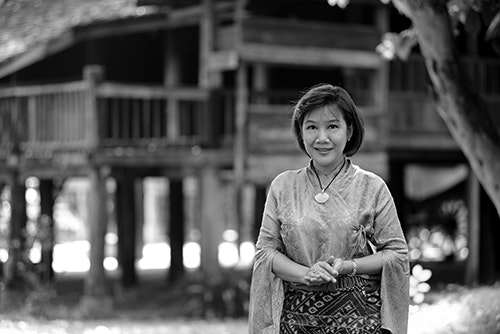
As Director of the Centre for the Promotion of Arts and Culture (CPAC), Assistant Professor and full-time lecturer of the Faculty of Thai Arts at Chiang Mai University (CMU), Vilawan Svetsreni-better known as ‘Ajarn Mai’ – is a very busy woman. She has an iPad and an iPhone, several websites, multiple email addresses and a Facebook page. She knows the words to Gangnam Style. And yet, she is trying to find a way, amidst Thailand’s mad dash toward modernity, to keep Chiang Mai’s rich Lanna history intact and relevant.
“Lanna Culture is not frozen,” says Ajarn Mai. “My wish is to preserve our cultural heritage, not like a stuffed crocodile in a museum but in a flexible, moving way. We need to understand our foundations, the history of our culture. Our past provides us with a model to build on, a direction for future development and innovation.”
While a student at Thammasat University in Bangkok, Ajarn Mai fell in love with Lanna culture through a rather unusual avenue: puppetry. She learned from some of the great masters of the ancient art how to build and manipulate the traditional hun krabok or rod puppets, which are handmade from wood and resin, painted and clothed in ornately embroidered fabrics.
“I love puppets because unlike most works of art, they don’t just sit there after they are made,” says Ajarn Mai, eyes sparkling with contagious enthusiasm. “They become alive!”
When Ajarn Mai arrived from Bangkok 16 years ago, her goal was to share her love of puppets with the student of CMU, simplifying traditional techniques and teaching the full gamut of Lanna puppetry arts, from building the puppet to learning how to operate it to putting together a final production in front of a live audience.
The Ajarn claims that she was once very shy about being onstage, but the puppets provided the perfect intermediary between herself and the audience.
“It’s an interesting phenomenon,” she points out. “The puppets take on a life of their own. When you criticise a student in a puppetry class, they don’t get upset. The puppet acts as the go-between.”
Ajarn Mai’s puppetry classes at CMU started out small but grew increasingly popular over the years, to the point that she had to start a waiting list. But this year, something changed, and only one person signed up for the class.
“I don’t know what happened,” Ajarn Mai says. “Maybe there were just too many other classes this semester, or maybe technology is winning, and students don’t have the time or the desire anymore to take part in something so traditional, something that involves so much hands-on craftwork and cannot be completed on a computer.”
The loss of interest in the traditional Lanna arts is a constant concern for Ajarn Mai.
“I cannot blame young people for modernising. But I think it’s important that we not turn these modern conveniences into an addiction or a way to show off,” she says. “As a teacher, it’s my job to introducepast traditions gently, not to force them down students’ throats. They will learn best by doing, by exploring and finding their own forms of appreciation through first-hand experience.”
It is with this spirit that Ajarn Mai is hosting CPAC’s first-ever Living Museum: Lanna Way of Life Festival, which will be held at their Lanna Traditional House Museum, a beautiful green space occupied by eight houses-all of which are over a hundred years old and have been transported and restored by CPAC.
Jointly sponsored by CMU and the Tourism Authority of Thailand (TAT), the festival is free and open to the public, and will feature a variety of different activities for children and adults alike. Each of the houses on the property will represent a different tribe or ethnic group who will set up shop, teaching visitors how to work with traditional crafts such as paper, umbrellas, fans, bamboo, silver, clay, wood and other textiles. The surrounding grounds will also feature traditional Lanna song and dance performances, food and craft stalls, and various other demonstrations and exhibitions.
Ajarn Mai hopes that it will offer an unprecedentedly fun and convenient way to learn by doing, encouraging locals and tourists alike to experience firsthand the living history that defines Chiang Mai.
“I’m not originally Lanna. I wasn’t born in Chiang Mai, but once I was exposed to the richness of the culture I was hooked. I think it’s important for people to find their own way to appreciate the past.”
The Living Museum:
Lanna Way of Life Festival
will take place 6 – 9 December
from 8:30 a.m. – 4:30 p.m. at the CMU Centre
for the Promotion of Arts and Culture,
located on the corner of Irrigation Canal and
Suthep Roads. As you drive along the Canal Road
towards Suthep, it is on your left hand side.
